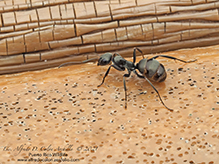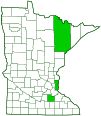icy mound ant
(Formica glacialis)
Conservation • Description • Habitat • Ecology • Distribution • Taxonomy
Conservation Status |
|
|||||||
| IUCN Red List | not listed |
|||||||
| NatureServe | NNR - Unranked |
|||||||
| Minnesota | not listed |
|||||||
Description |
||
Icy mound ant is a northern, cold climate ant. It occurs in formerly glacier covered areas of North America. In the United States it occurs from Maine to New York, west to eastern North Dakota and northern Illinois. It also occurs in southern Canada from Newfoundland to Saskatchewan. It is most common in Maine and New Hampshire in New England, and in Michigan, Ohio, and Quebec in the central Great Lakes region. It is less common in Minnesota. It is found in open fields, early successional shrublands, woodlands, woodland edges, fens, and wetlands. Icy mound ants have been reported feeding on flower blooms of Queen Anne’s lace and goldenrods, on honeydew, and on smashed apples. They have also been recorded tending planthoppers and aphids. Winged males fly in July and August. Workers forage on the ground, on tree trunks, and on plant foliage. Icy mound ants usually build large, low, spread-out mounds, but some mounds can be up to 40″ (1 meter) high. The colonies are hosts for the slave-maker ants Pergande’s mound ant (Formica pergandei) and obligate slave-making mound ant (Formica subintegra), and for the temporary social parasite Dakota mound ant (Formica dakotensis). Workers are uniformly dark brownish-black to black, shiny, and ⅛″ to ¼″ (3.9 to 6.5 mm) in length. They have a pronounced silvery sheen on the head, body, and legs due to numerous flattened (appressed) silvery hairs. The top of the head is covered with dense, silvery, appressed hairs. It is not distinctly concave. The plate on the face (clypeus) is not notched on the lower margin. On each cheek, the area between the eye and the base of the mandible is not covered with coarse, elongated pits (punctures). The jaws (mandibles) are dark reddish-brown with black edges. Each mandible has one or two offset teeth at the base, the part closest to the head. The antennae are slightly paler toward the base. The basal segment of each antenna (scape) is long, but it is shorter than the length of the head. The front part of the body (mesosoma) is mostly covered with dense, silvery, appressed hairs. The front part of the mesosoma (promesonotum) usually has no hairs, sometimes just one or two small erect hairs. The rear part of the body (gaster) has many erect hairs. The first two segments (tergites) are also covered with dense, silvery, appressed hairs. The erect hairs on the first tergite are especially abundant, and the appressed hairs on the third segment are much sparser than on the second tergite. This is an important identifying feature for this species. The glossy sheen of the third tergite is not obscured by hairs. The legs are slightly paler toward the end except at the tips. They are covered with dense, silvery, appressed hairs. |
||
Size |
||
Total length: ⅛″ to ¼″ (3.9 to 6.2 mm) |
||
Similar Species |
||
Habitat |
||
Open fields, early successional shrublands, woodlands and woodland edges, fens, and wetlands |
||
Ecology |
||
Season |
||
Winged males fly in July and August. |
||
Behavior |
||
|
||
Life Cycle |
||
|
||
Food |
||
Flower blooms and honeydew of aphids and planthoppers |
||
Distribution |
||||
|
Sources |
|||
| 8/7/2023 | ||||
Occurrence |
||||
|
||||
Taxonomy |
|||
Order |
Hymenoptera (ants, bees, wasps, and sawflies) | ||
Suborder |
Apocrita (narrow-waisted wasps, ants, and bees) | ||
Infraorder |
Aculeata (ants, bees, and stinging wasps) | ||
Superfamily |
Formicoidea (ants) | ||
Family |
Formicidae (ants) | ||
Subfamily |
Formicinae | ||
Tribe |
Formicini | ||
Genus |
Formica (wood, mound, and field ants) | ||
| no rank | fusca-group field ants (Formica fusca group) | ||
This species was formerly classified as the subspecies Formica fusca glacialis. |
|||
Synonyms |
|||
Formica fusca fairchildi Formica fusca glacialis |
|||
Common Names |
|||
icy mound ant |
|||
Glossary
Clypeus
On insects, a hardened plate on the face above the upper lip (labrum).
Gaster
The bulbous part of the abdomen of ants, bees, and wasps. In ants it usually begins at segment three.
Mesosoma
In Hymenoptera: the front part of the body, consisting of all three segments of the thorax and the first segment of the abdomen, to which the wings are attached.
Scape
In plants: An erect, leafless stalk growing from the rootstock and supporting a flower or a flower cluster. In insects: The basal segment of the antenna.
Tergite
The upper (dorsal), hardened plate on a segment of the thorax or abdomen of an arthropod or myriapod.
Visitor Photos |
|||||
Share your photo of this insect. |
|||||
| This button not working for you? Simply email us at info@MinnesotaSeasons.com. Attach one or more photos and, if you like, a caption. |
|||||
Alfredo Colon |
|||||
 |
|||||
MinnesotaSeasons.com Photos |
|||||
|
|||||

Slideshows |
||

Visitor Videos |
|||
Share your video of this insect. |
|||
| This button not working for you? Simply email us at info@MinnesotaSeasons.com. Attach a video, a YouTube link, or a cloud storage link. |
|||
Other Videos |
|||
| Ants Formica Glacialis Doing Their Spring Cleaning pascalnet |
|||
About
Mar 5, 2012 Recorded on April 20th 2007 in Victoriaville, Québec, Canada. |
|||

Created: 8/8/2023
Last Updated:


